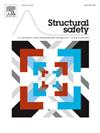Target low-carbon conditional probability for low-carbon structural design
IF 6.3
1区 工程技术
Q1 ENGINEERING, CIVIL
引用次数: 0
Abstract
Probabilistic low-carbon structural design is an emerging method for mitigating structural embodied carbon, whereas the absence of a rational target for probabilistic regulation hindered its effectiveness. Here, we clarify the necessity of verifying the low-carbon conditional probability in low-carbon design of structures/structural members, and propose methods for determining acceptable and optimal low-carbon conditional probabilities (i.e., PLT,a and PLT,o), respectively based on the carbon mitigation obligation for construction sector and the carbon-related cost minimization for structures/structural members. Based on typical levels of parameter values for target determination, we reveal that PLT,a is primarily influenced by the distributions of structural embodied carbon premised on safety Is and its embodied carbon limit Icr,c, and it typically decreases with the decrease in the difference between the coefficients of variance of Is and Icr,c. The reduction of marginal cost for embodied carbon reduction (k), the increase of relative carbon cost (uc), and the increase of penalty for the excess of carbon emissions (γp) facilitate the attainment of the lowest carbon-related cost at lower embodied carbon levels, where a higher PLT,o could be specified to promote stricter carbon mitigation efforts. The target low-carbon conditional probability PLT is recommended to be taken as the larger of PLT,a and PLT,o, while the γp required to ensure that the lowest carbon-related cost is reached with PLT increases as k increases or uc decreases.
针对低碳结构设计的低碳条件概率
概率低碳结构设计是一种新兴的减少结构隐含碳的方法,但缺乏合理的概率调控目标阻碍了其有效性。本文明确了在结构/构件低碳设计中验证低碳条件概率的必要性,提出了基于建筑行业碳减排义务和结构/构件碳相关成本最小化的可接受低碳条件概率(PLT,a)和最优低碳条件概率(PLT,o)确定方法。基于目标确定参数值的典型水平,我们发现PLT,a主要受以安全is为前提的结构隐含碳分布及其隐含碳限值Icr,c的影响,并随着is与Icr,c方差系数差的减小而减小。实际碳减排边际成本(k)的降低、相对碳成本(uc)的增加以及对超额碳排放的惩罚(γp)的增加,有助于在较低实际碳水平下实现最低碳相关成本,在这种情况下,可以规定较高的PLT,o以促进更严格的碳减排努力。建议将目标低碳条件概率PLT取PLT、a和PLT中较大的一个,而确保PLT达到最低碳相关成本所需的γp随k的增大或uc的减小而增大。
本文章由计算机程序翻译,如有差异,请以英文原文为准。
求助全文
约1分钟内获得全文
求助全文
来源期刊

Structural Safety
工程技术-工程:土木
CiteScore
11.30
自引率
8.60%
发文量
67
审稿时长
53 days
期刊介绍:
Structural Safety is an international journal devoted to integrated risk assessment for a wide range of constructed facilities such as buildings, bridges, earth structures, offshore facilities, dams, lifelines and nuclear structural systems. Its purpose is to foster communication about risk and reliability among technical disciplines involved in design and construction, and to enhance the use of risk management in the constructed environment
 求助内容:
求助内容: 应助结果提醒方式:
应助结果提醒方式:


